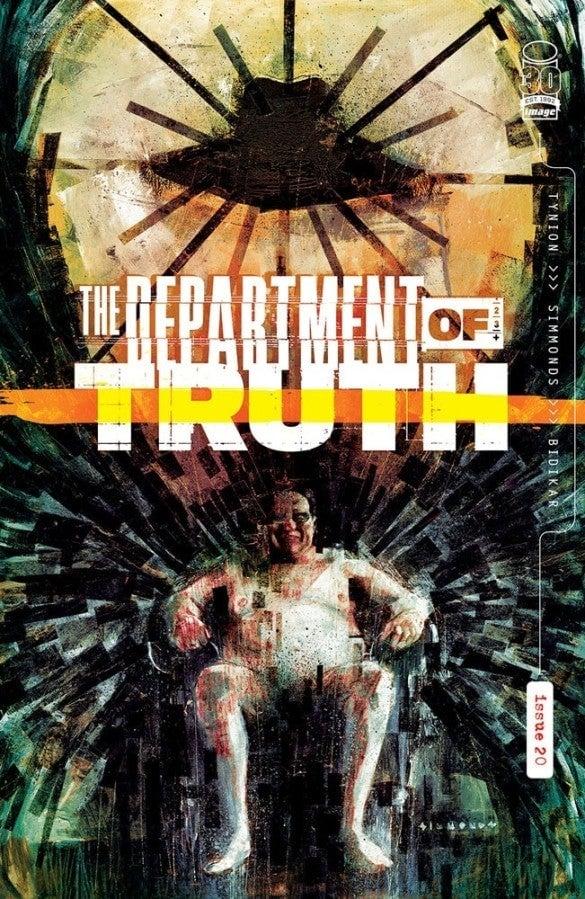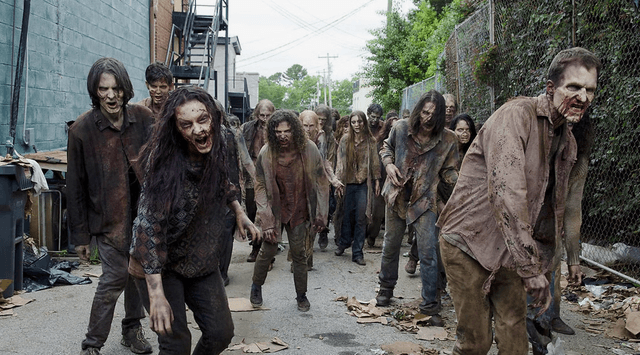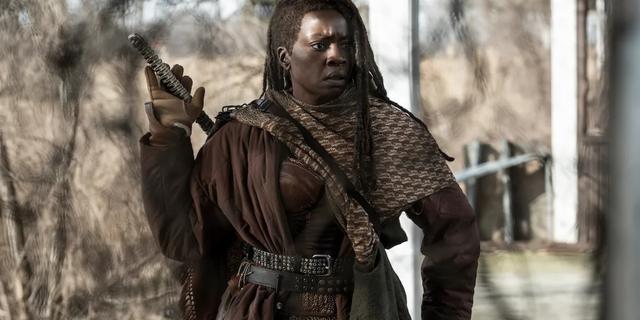If you click on a link and make a purchase we may receive a small commission. Read our editorial policy.
The scariest thing in 'The Department of Truth' is us
'The Department of Truth' is one of the best comics on the stands right now
We're living in a very exciting time for horror comics, from the prolific output of Cullen Bunn to the continued masterworks of Junji Ito, but even amid a crowded field of creators, writer James Tynion IV has managed to become a particular standout. Through series like Something is Killing the Children, The Nice House on the Lake, and even certain especially dark threads of his run on Batman, Tynion has proven time and time again that he's able to tap into primal fears on the comics page, delivering stories that are as terrifying as they are engaging.
Of all Tynion's many forays into scary comics, though, The Department of Truth stands out.
Launched in 2020 by Tynion and artist/co-creator Martin Simmonds, the series is a deep dive into the undeniable allure of conspiracy theories, and over the course of its first two years. it's covered everything from Bigfoot to Mothman to the secrets buried beneath the Denver airport. Driven by Simmonds' nightmarish, Dave McKean-esque art and Tynion's extended explorations of America's secret history, it's an enormously entertaining book that also might just be the most terrifying thing Tynion has written. And given his career so far, that's really saying something.

So what is it about The Department of Truth that makes it so simultaneously addictive and scary? What makes this book somehow more frightening than the lives of those survivors in the house by the lake, or the monster-hunting exploits of Erica Slaughter?
Put simply, it's us. We are the most terrifying thing in The Department of Truth, and given the book's many depictions of monsters both real and imagined, that's quite a storytelling achievement.
Tynion introduces us to the title entity – The Department of Truth - a secret government agency spearheaded by a man who may or may not be Lee Harvey Oswald – through the eyes of Cole Turner, an FBI agent who specializes in conspiracy theories and the people who believe in them. Cole seems like a relatively normal guy. He's got a job he's good at, a husband he loves, and a healthy skepticism that makes him a dogged and smart investigator. Those investigative skills, plus his area of expertise, make him a perfect recruit for The Department of Truth, which Cole learns about after a strange experience during which he thinks he maybe, possibly, saw evidence that the Earth is actually flat.
The thing is, of course, that the Earth isn't flat…not until enough people believe it is, anyway.
The Big Secret
Cole's initiation into The Department of Truth hinges on what Tynion, through Oswald's mouth, refers to as "The Big Secret," and it's here that the real conceptual brilliance of the book begins. The Big Secret is not that all, or even some, conspiracy theories are true. It's that any and all conspiracy theories are capable of being true, depending on the level of belief that's out there in the public consciousness. If enough people believe the Earth is flat, you can literally fly out to the sides of the map and look at the edge of the world. If enough people believe Bigfoot is real, Bigfoot will start walking around in the woods. As Oswald puts it in the very first issue: "The more people believe in something, the more true that thing becomes."

Therefore, The Department of Truth's job is to not just control public perception, putting some wild theories to bed while promoting others. It's to literally shape the narrative of American life, often in opposition to the narrative other nations like Russia would like to submit to the world stage. Once the big secret is revealed, Cole is catapulted into a strange and terrifying odyssey that reveals to him hidden truths about both himself and America at large, and sets him on a path from which he might never be able to turn back.
Though there's a larger narrative at play in the comic, much of it involving a shadowy opposition group known as 'Black Hat,' Tynion structures much of The Department of Truth in the form of individual issues each devoted to a different conspiracy theory, cryptid, or strange phenomena, all filtered through Cole's (or, in some flashback cases, Oswald's) eyes.
We learn why Bigfoot always appears blurry in pictures, why it's so hard to corroborate evidence of something like the Mothman, why the Satanic Panic of the 1980s was so pervasive, and so much more, often unspooled for us through lengthy monologues coming from expert characters who are attempting to teach Cole about the true nature of his world. Entire issues are devoted to deep dives on Aleister Crowley and the strange alien being known as Indrid Cold, and caption boxes deliver information in often vast detail, but somehow it never reads like an extended lecture on American arcana. Some of that is thanks to Tynion's innate skill as a storyteller. He just knows how to deliver all of this information in a way that's both digestible and deeply compelling, no matter how long-winded his characters might become. Much of the power of these passages, though, comes from Simmonds, who channels Hieronymous Bosch and Francis Bacon and Dave McKean into landscapes of pure nightmare fuel, imbuing each page with meaning and power even beyond the scope of Tynion's words.
So yes, The Department of Truth is an acclaimed exercise in great craft, and a surefire lure for anyone interested in conspiracies, but the real secret to its spellbinding nature lies in something deeper.
The Department of Story
The more Cole grasps the scope of the world he's been plunged into, the more he comes to understand that The Department of Truth are storytellers, in the same way that Tynion, Simmonds, and their collaborators are storytellers. Their job is to shape the reality, the narrative, of their world as they see fit, revising and retconning along the way as is necessary, to fit a certain perception, using tried and true narrative tools like symbolism and repetition along the way. It suggests a world in which the rhyming of history is no accident, in which the shifting of the American way of life across decades is not dictated by the chaotic nature of the world, but by careful architects sat behind the biggest story engine the world has ever known. This is both awe-inspiring and terrifying to Cole, especially as he realizes just how deeply he's embedded, and how close his current job is to a childhood trauma that he thought was behind him.

This positioning of The Department of Truth as storytellers and the American consciousness as the blank page on which they write their tales, is the core of what makes the series work, because it asks us to examine not just conspiracy theories, but the very nature of truth in our daily lives. After all, we are also each storytellers in our own way. We curate our news feeds to fit our worldview, match the stories we consume to our opinions and moods, and build elaborate coping mechanisms to steel ourselves against the reality of daily life. If we want the world to be all adorable cat videos and TV shows about home remodeling, we can make it that way. If we want to believe that the country is run by Satan-worshiping, child-devouring reptile people, we can find the twisted prism that will allow us to see things exactly that way. These are not new observations, but The Department of Truth asks us to take those observations and view them writ large.
If enough of us frame our worldview in one particular way, does that mean the entire world will then see things that way? If we all view the video of the Moon Landing in 1969 as objective truth, does that mean it's actually objective truth, or does that mean we've simply chosen to view it that way? If enough people believe zombies are real, and zombies eventually manifest, do they manifest because they're real or because we wanted them to be real? Collective belief, or collective disbelief, is an immensely powerful thing, and being able to wield it is a state of even greater power. The Department of Truth, through breathtaking comics craft and its own dark view of storytelling, asks us to question not just our collective beliefs, but what our role in shaping those beliefs might be, and in the process makes us wonder if we believe what we believe because it's true, or because it's all part of a larger game.
Because we're capable of believing just about anything, the scariest thing in The Department of Truth is us, and that's why, after two years, it remains one of the best comics you can read right now, an essential horror book in a world full of great scary stories.
The Department of Truth issue #20 is now available for purchase at your local comic shop and online.
Follow Popverse for upcoming event coverage and news
Find out how we conduct our review by reading our review policy
Let Popverse be your tour guide through the wilderness of pop culture
Sign in and let us help you find your new favorite thing.
















Comments
Want to join the discussion? Please activate your account first.
Visit Reedpop ID if you need to resend the confirmation email.